by Celeste Lipford and Terry Lipford - last updated on 9/25/2025
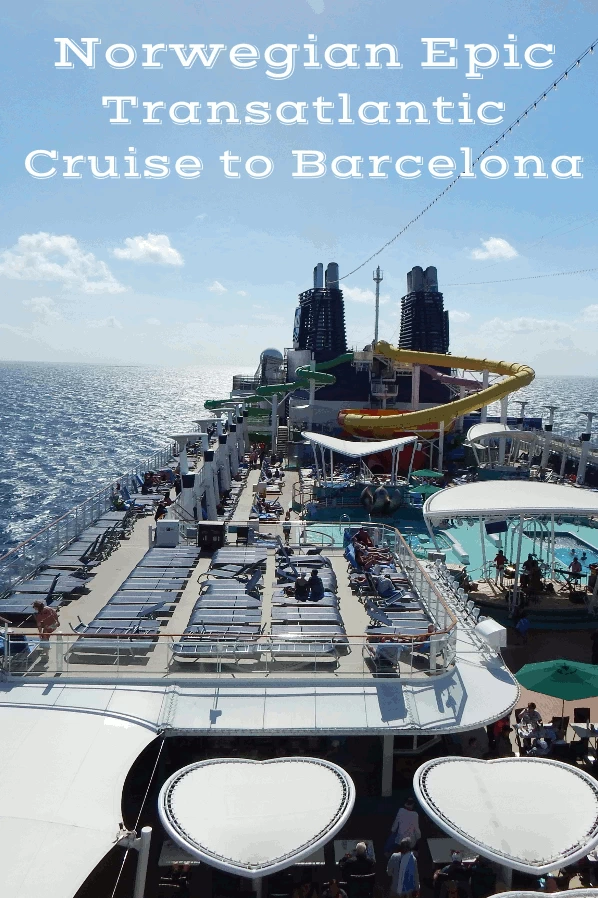
Our ship docked in Cádiz, but our plan was a full day trip to Seville. We took the train from Cádiz to Sevilla, explored the historic core (Cathedral, Giralda, Alcázar area, and tapas), then returned in time to reboard. Here’s exactly how we did it, plus a few quick notes for a short Cádiz wander before sailing.
We were onboard the Norwegian Cruise Lines 'Epic' on a repositioning cruise from Port Canaveral, FL to Barcelona with various stops along the way - the third stop being Cadiz. Based on the historical significance of Seville and all that we'd read about it we chose to travel to Seville for the day by train instead of spending our time in Cadiz. Cadiz is 4,456 sea miles from Port Canaveral and 637 sea miles northwest of Funchal Madeira. Cádiz is one of the oldest continuously inhabited cities in Western Europe, with archaeological remains dating back 3,100 years & was founded by the Phoenicians. It has been a principal home port of the Spanish Navy since the accession of the Spanish Bourbons in the 18th century. The city is a member of the Most Ancient European Towns Network. It is also the site of the University of Cádiz.
Caution: If you are coming here on a tour, then you can disregard this text. If you have come here via train from a cruise ship in Cadiz then read on; Seville is a large city, however, the old historic area is relatively condensed and can be easily reached from the San Bernardo Train Station. Since you will be on a schedule based upon the required time to reboard your cruise ship, you are going to have to plan your Seville exploration carefully and keep an eye on your clock!
We discovered that the cost of the Norwegian Cruise Lines tour to Seville was expensive, so we did some research and found that we could create our own game plan. Renfe trains, Spain's main operator, offer frequent departures throughout the day, with journey times varying from 1 hour 23 minutes to 1 hour 41 minutes. Relax in comfortable seats, enjoy ample legroom, and utilize onboard amenities like Wi-Fi and charging points.
If you are on a cruise ship, and if you are interested in taking the same type of trip we took to Seville, then click here to go to the page section where we describe how to do it. We had a good time, we spent far less money than the ship's tour would have cost, and the train ride was comfortable and fast.
According to a 2023 census estimate, the population of the city of Cádiz was 111,811 (the second most populated of the province after Jerez de la Frontera with 212,830 inhabitants), and that of its metropolitan area was 629,054. Cádiz is the seventeenth-largest Spanish city. In recent years, the city's population has steadily declined; it is the only municipality of the Bay of Cádiz (the comarca composed of Cádiz, Chiclana, El Puerto de Santa María, Puerto Real, and San Fernando), whose population has diminished. Between 1995 and 2006, it lost more than 14,000 residents, a decrease of 9%.
Among the causes of this loss of population is the peculiar geography of Cádiz; the city lies on a narrow spit of land hemmed in by the sea. Consequently, there is a pronounced shortage of land to be developed. The city has very little vacant land, and a high proportion of its housing stock is relatively low in density. The older quarters of Cádiz are full of buildings that, because of their age and historical significance, are not eligible for urban renewal.
Christopher Columbus's third voyage (1498-1500) started from Seville, Spain on May 30, 1498.
Christopher Columbus’s burial site is a topic of historical debate, as his remains have been moved multiple times. Columbus’s most widely accepted tomb is inside the Seville Cathedral, one of the largest Gothic cathedrals in the world.
Seville is approximately 2,200 years old. The passage of the various civilizations instrumental in its growth has left the city with a distinct personality, and a large and well-preserved historical centre.
Yes, in 1519, Ferdinand Magellan departed from Seville for the first circumnavigation of the Earth.
Yes, Seville Cathedral, a UNESCO World Heritage Site, is the largest Gothic cathedral on the planet and houses the tomb of Christopher Columbus.
Yes, while Flamenco is popular across Spain, its origins trace back to Andalusia, with Seville being a major hub for this passionate art form.
The city is home to three UNESCO World Heritage Sites: the Cathedral, the Alcázar Palace complex, and the General Archive of the Indies.
Seville's stunning architecture has made it a popular filming location, including for the popular TV series Game of Thrones. Click this link icon to view the entire list.
Seville is considered the capital of flamenco, the vibrant and soulful Spanish art form of music and dance that originated in the region.
Seville is known for its intense summer heat, with July and August temperatures frequently exceeding 35°C (95°F), earning it the nickname "El Sartén" (The Frying Pan).
Since the majority of this visit was about Seville as opposed to Cadiz (where we did not spend much time), from here on out everything will be about Seville.
The ship arrived in Cadiz harbor at 7AM, but passengers were not allowed to disembark until nearly 8AM (Spanish Customs, etc). We headed straight to the Cadiz Train Station (located at Plaza Sevilla) to obtain train tickets for Seville. It is only a kilometer walk from the cruise pier, but the Cadiz Port authorities required all passengers to take a shuttle bus to the Cruise Port entrance - so our walk began there. Somewhat out of our intended direction, but still just a walk down the Avenue del Puerto to the Plaza de Sevilla and the ADIF-RENFE Train Station.
Most trains will stop at the Santa Justa Seville Train station, however, this leaves you with an approximately 2.5 kilometer walk to reach the Plaza de Espana area. So we selected a train that stopped at the San Bernardo Station (image #2 above) which resulted in a 900 meter walk via Avenue Portugal. You could take any other train to the Santa Justa station and then take a taxi to the historic area, we took the walk because we felt like stretching out after a 90 minute train ride.
IMAGE CREDIT: The San Bernardo Train Station image above is the property of CarlosVdeHabsburgo via Wikimedia using the Creative Commons CC BY-SA 4.0 license.
Ticket Purchases at the Cadiz Train Station
The Cadiz Train Station (image #1) offers two methods of purchasing tickets, one being the typical "Ticket Counter" method and the other being automated ticket machines. Since we knew from previous European Travels that the automated machines might not work with American credit cards, Celeste went to see if the machine would accept our credit cards and I stayed in the ticket counter line. It was a good thing that we took this strategy, because the automated machines required a "contactless" credit card. There was no chip reader or swipe reader. Our credit cards were not contactless so they didn't work. Even the Ticket Counter card reader failed to read our card, so we wound up utilizing cash so that we could hurry and catch the train before it departed! Always carry cash is rule #1 on our European Travel Tips page.
The local train is a 90 minute ride to Seville from Cadiz (several stops along the way), and of course a 90 minute return ride. Make sure you have enough time for the train ride and arrive back in Cadiz well before the departure time for your ship. Fortunately our ship was not scheduled to depart until 7:30PM so we had more than enough time to do a "just traveling through" adventure in Seville! We saved a lot of money by not taking the ships shore excursion. The train ride was only €23.50 per person for the round trip - compare that to the ship excursion prices where the least expensive was €119 and the most expensive was €329 per person round trip. Yes, the ship excursions were done by bus, but when we inquired at the excursion desk as to what was included in those prices, they were not able to tell us!
Once you arrive in Seville, the local train stops at the Seville Metro Stations as well as the central train station. Santa Justa is the main train station, however we left our train at the San Bernardo train station (image #2) because it is much closer to the areas of Seville we wanted to visit.
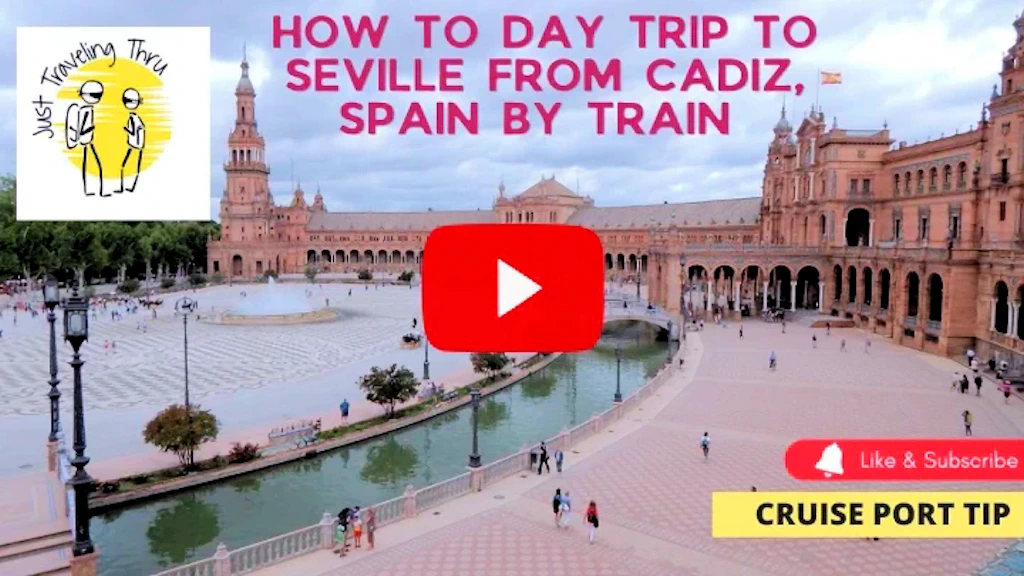
If you enjoy our videos click here to subscribe to our Youtube Channel.
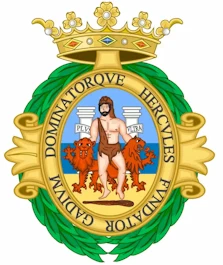
Click the above image to watch this video which will show you how to Day trip to Seville Spain by train from the Cadiz cruise port. In addition, we’ll show you some of the sites to see in Seville and some tips to make your trip successful. We travel thru, and sometimes we make mistakes, hopefully, we learn from those mistakes and then we share the info with you so you don’t make the same mistakes. Seville Spain has some beautiful sites and it’s a must-see city in Spain.
Located within the heart of Seville, Spain, the Parque de María Luisa (Maria Luisa Park) stands as a serene oasis where nature's splendor intertwines with human creativity. This enchanting park, adorned with lush foliage, meandering pathways, and vibrant flowerbeds, offers a sanctuary of tranquility amid the bustling city. Majestic fountains and ornate monuments add a touch of grandeur to the landscape, while the gentle embrace of the Guadalquivir River bestows a serene backdrop. As sunlight filters through the canopy, casting dappled shadows on cobblestone paths, visitors are invited to wander through its verdant embrace, discovering hidden corners, peaceful ponds, and the timeless allure of Andalusian charm.
The park is located adjacent to the Plaza de Espana, and it serves as a botanical garden. Many plant species, native or exotic, are represented, along with educational panels to inform the visitors to the park. Many birds make their home in the park, which is known for its large population of doves (for which a part of the Plaza de América is called the Parque de las Palomas, or Dove Park). There are also many parakeets living in the centre of the park, and ducks and swans in the fountains and lakes.
The park is 40 hectares (99 acres) in size, and contains a half mile of tiled fountains, pavilions, walls, ponds, benches, and exhedras.
More Info for the Parque de María Luisa & Image Credits
After leaving the San Bernardo Train Station, we walked over to the Plaza de Espana by walking west on Avenue Portugal. This is one of those "must see" places in Seville, and it is beautiful; surrounded by the Parque de Maria Luisa which contains a wide variety of beautiful flowers, trees, shaded paths, etc. Most of the grounds that were used for the park were formerly the gardens of the Palace of San Telmo. They were donated to the city of Seville in 1893 by the Infanta Luisa Fernanda, Duchess of Montpensier, for use as a public park.
The Plaza de Espana is a semi-circular brick building, Renaissance/neo-Moorish in style, with a tower at either end (tall enough to be visible around the city, these towers - north and south - are major landmarks). In front of the building, following the curve of its facade, is a 500-metre canal crossed by four bridges, and in the centre of it all is the Plaza itself. You can rent small boats to row in the canal - the Plaza is known as "the Venice of Seville". A major tourist attraction, it is the finishing point of horse-and-carriage rides.
After exploring the Plaza de España main entrance and glancing over the map of the area, it quickly became clear that Seville had far more to offer than we could possibly fit into our limited window of time. With the ship scheduled to depart Cádiz at 7:30 PM, we needed a way to see as much of the city as possible without wearing ourselves out. So, we opted for a horse-drawn carriage tour—a charming, if slightly touristy, way to cover ground quickly.
At €50 for the two of us, it wasn’t the cheapest option, but the experience was undeniably worth it. Gliding through Seville’s elegant boulevards and leafy parks, we were able to take in the sights at a relaxed pace, without constantly checking the clock. Our carriage driver offered bits of commentary along the way; although his English was limited, we still appreciated the snippets of local history and insight he shared. It was a scenic and stress-free way to get a feel for the city, and in hindsight, a perfect choice given our tight schedule.
Click this video image to start that video playing, and then when the YouTube "video controls" appear at the bottom of the video, then click the "square" in the lower right corner of the video to make the video appear "full screen" & then click the "play" button. Once the video has completed, push your computer's "escape key" to minimize the video again.
Or click here to subscribe to our Youtube Channel.
Our carriage ride ended near the Real Alcázar of Seville, the city’s breathtaking royal palace. We were eager to explore it—until we saw the line. It wrapped completely around the block, a clear sign that the palace’s popularity was no joke. In hindsight, we definitely should have reserved tickets in advance. We broke one of our own golden rules of travel: always research high-demand attractions before arrival, especially when you're on a tight schedule. Unfortunately, with our limited time in Seville, waiting in that line just wasn’t an option.
More Info for the Plaza de España, Seville & Image Credits
From the Royal Palace, we made our way on foot to Plaza del Triunfo, a scenic square nestled between some of Seville’s most iconic landmarks. From there, we continued along Avenida de la Constitución, one of the city’s main thoroughfares. As you can see in the photos above, this area is an eclectic blend of historic charm and modern energy. Grand old buildings sit alongside contemporary storefronts, and the streets are lined with a lively mix of restaurants, pubs, shops, and local businesses. This stretch of the city gave us a glimpse into the everyday rhythm of Seville—a refreshing contrast to the postcard-perfect historic core. In many ways, it felt like we were walking through both the past and present of the city at the same time.
Image #2 is the Seville Metro route which runs down the center of Avenue de la Constitucion, which made the comparison between old & new even more distinct than just the buildings themselves!
With no specific destination in mind, we wandered leisurely along Avenida de la Constitución, soaking in the atmosphere. We spent time people-watching, browsing local shops, admiring the unique blend of architectural styles, and pausing to enjoy the occasional burst of street performance art. One act in particular caught everyone’s attention—a performer who appeared to be floating effortlessly in mid-air (see image #2). We stood there trying to figure it out, and we weren’t alone—passersby stopped, stared, and scratched their heads, equally puzzled by the illusion. Even now, we’re still not sure how he pulled it off, but it definitely added a touch of mystery and fun to our spontaneous stroll.
Eventually, we had to tear ourselves away from the charm of central Seville and start making our way back toward the Cathedral and Royal Palace, retracing our steps with the looming awareness that time was running short. We needed to be at Santa Justa Train Station with enough buffer to comfortably make our return to Cádiz before the ship’s departure. As we continued east, we passed through some interesting neighborhoods—off the main tourist trail, but full of local character. By the time we reached Calle José María Moreno Galván, it became clear that walking the rest of the way wasn’t an option. The train station was still a few miles off, and our cushion of time was quickly disappearing. We knew we had to act fast—it was taxi time.
As we continued our eastward walk, we kept an eye out for a taxi—ready to hop in the moment one appeared. It wasn’t until we reached Calle José María Moreno Galván that we finally spotted one and managed to flag it down. Thankfully, the driver got us to Santa Justa Train Station promptly, and we boarded the return train to Cádiz with time to spare.
Back in Cádiz, with the ship still at port and a bit of daylight left, we found the perfect way to unwind—a cozy tapas bar just outside the cruise terminal. We grabbed a couple of well-earned adult beverages and toasted to our whirlwind adventure in Seville. Despite the time crunch, the day had been a success, and we were glad we’d taken the chance to explore such a vibrant city—even if only briefly.
The place we decided to stop at, was La Vaca Atada ("The Tied Cow") located at Calle Nueva, 1D, 11005 Cádiz, Spain - which is directly across the street from the Cruise Port entrance on Avenue del Puerto. While their website is in Spanish, we found the staff to be welcoming and happy to speak English. It was the perfect spot to end the day—good food, cold drinks, and a view of the harbor as the sun dipped toward the horizon.
We used the regular train: Cádiz ⇄ Sevilla (arriving at Sevilla Santa Justa). It’s straightforward—buy tickets, ride into Seville, then connect on foot/taxi to the historic center.
We bought tickets aligned to our ship’s timetable and chose departures that maximized Seville time with a safe return window. Travel time is roughly in the “about an hour-plus” range; verify current schedules before you go.
We focused on the Cathedral & Giralda exterior, the Alcázar area (outside views if lines are long), Plaza de España, Santa Cruz lanes, and tapas. It’s a walkable loop with short taxi hops if needed.
We aimed to be back at Cádiz station with a comfortable buffer before all-aboard. Build in extra time for ticket queues or delays and choose an earlier return train than the last possible one.
Yes—on our return we fit in a short Cádiz stroll near the old town for photos and a snack. Keep it compact so you stay well inside your reboarding window.
Light daypack, water, sun protection, comfortable shoes, and a charged phone for maps/tickets. Keep an eye on the time so you don’t rush the return.
Yes, Seville is wheelchair accessible, as it is a relatively flat city with accessible public transportation, including a metro with lifts and accessible buses. While most major attractions like the Cathedral and parts of the Alcázar are accessible, some older areas may have limitations, so checking accessibility for specific sites is recommended. Accessible taxis and tours are also available, and the city is known for its compact, pedestrian-friendly areas.
Plan Your Day Trip – Cádiz to Seville Travel Resources — Maps, Parking, Passes & Links
You should be aware that Norwegian Cruise Lines (NCL) varies where their ships go, as well as what ships they will reposition. To determine where NCL is sending what ships, you should visit their website. Our list of ports below, is based upon what the "Epic" did when we were onboard in 2019.
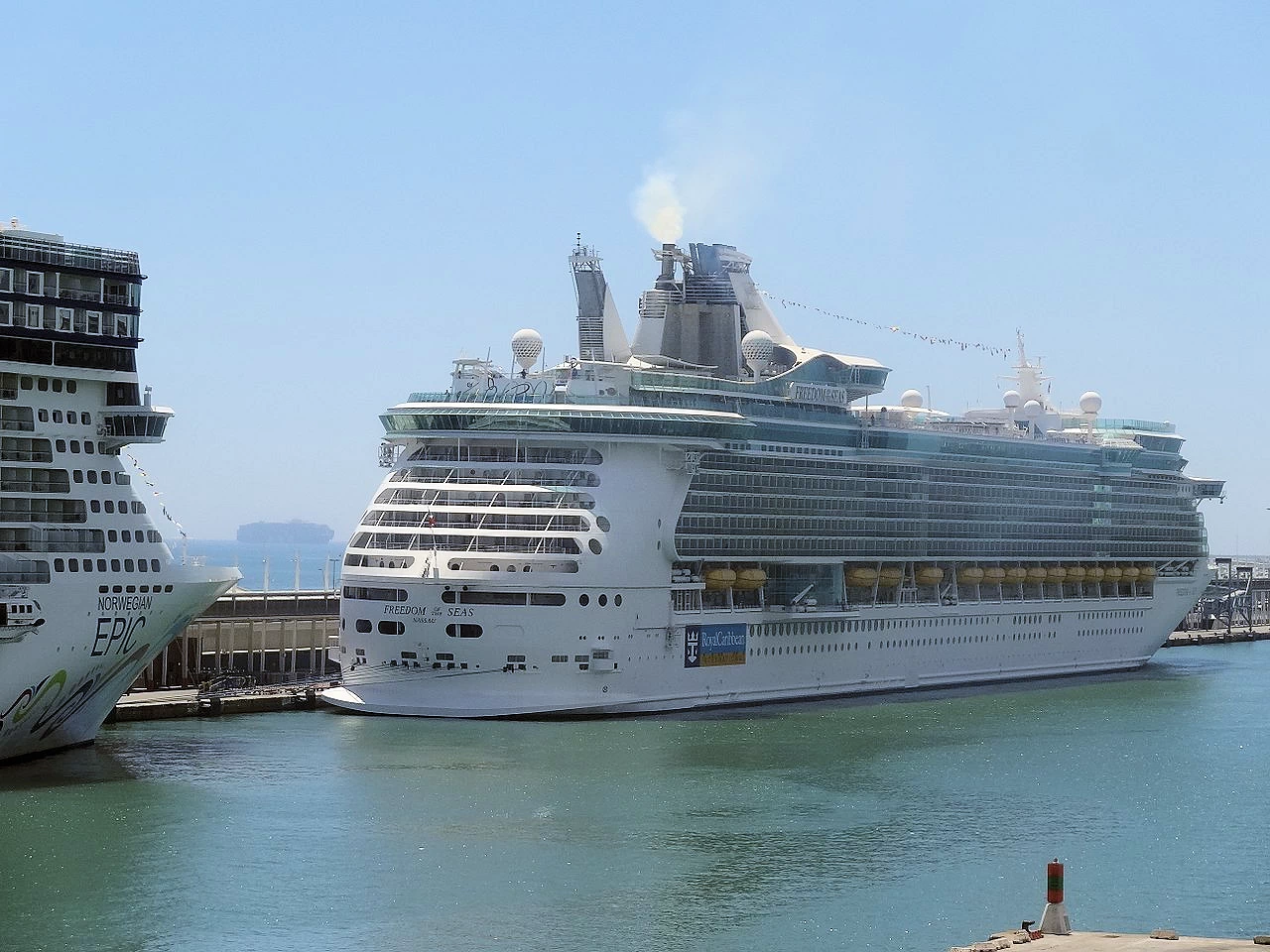
Norwegian 'Epic' Cruise Overview
Click here to read more on our Cruise Overview Page
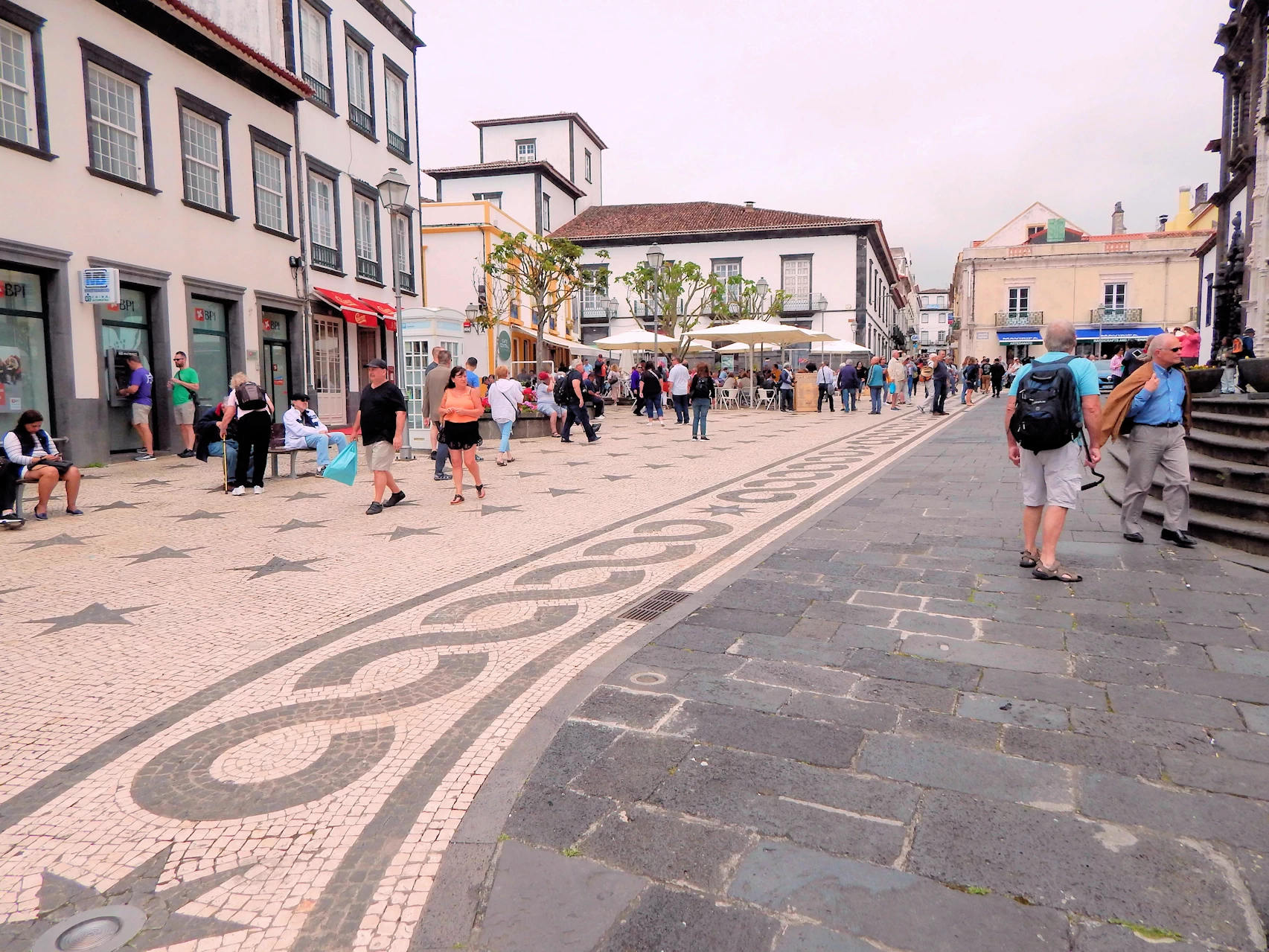
Ponta Delgada, Portugal
Click here to read more on our Ponta Delgada Page
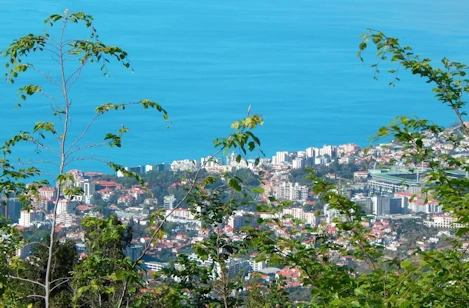
Funchal Madeira Portugal
Click here to read more on our Funchal Page
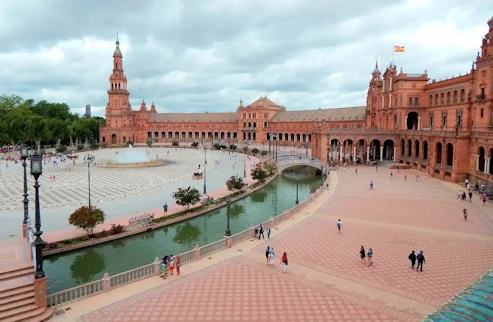
Cadiz/Seville, Spain
Click here to read more on our Cadiz/Seville Page
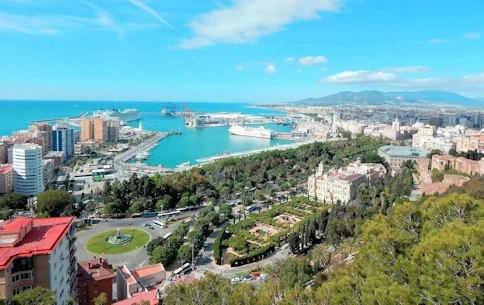
Malaga, Spain
Click here to read more on our Malaga Page
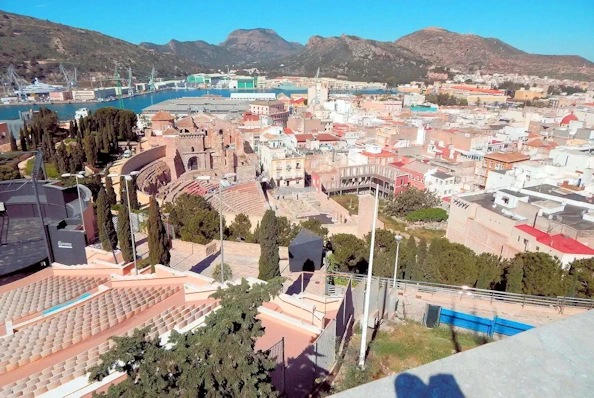
Cartagena, Spain
Click here to read more on our Cartagena Page
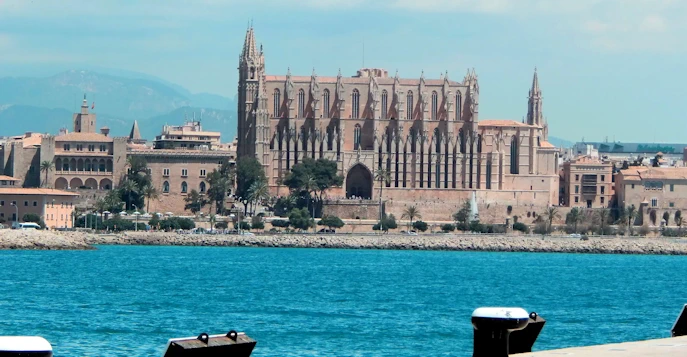
Mallorca, Spain
Click here to read more on our Mallorca Page
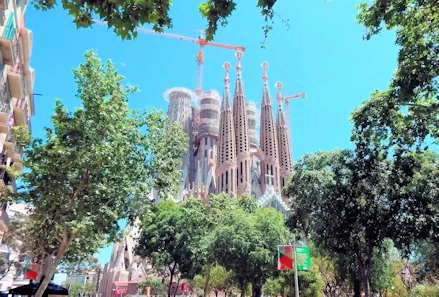
Barcelona, Spain
Click here to read more on our Barcelona Page
Note: All images featured on this page are the exclusive property of Just Traveling Thru, LLC, unless otherwise stated. When images from external sources are used, full credit is given to the original creator, along with a link to the specified license or usage terms. We are committed to respecting copyright and intellectual property rights, ensuring that all third-party images are properly attributed. If you have any questions regarding image ownership or usage rights, please feel free to contact us.
Affiliate Links: We may earn a commission if you make a purchase through one of our affiliate links. This helps support our travel content — thank you!
Content: To review any of our content, make suggestions and/or comments, please click the "About" menu link at the top of this page. You will find our "Contact Us" link on that drop-down menu.